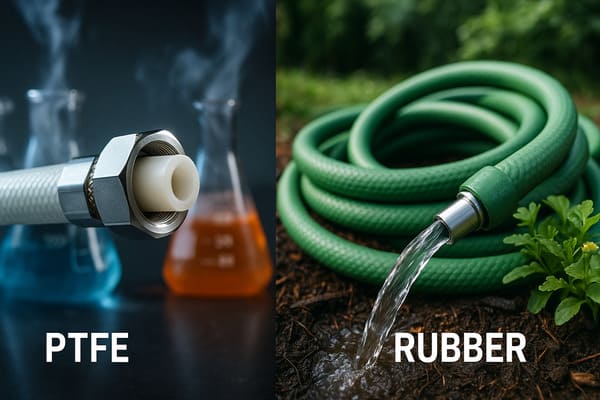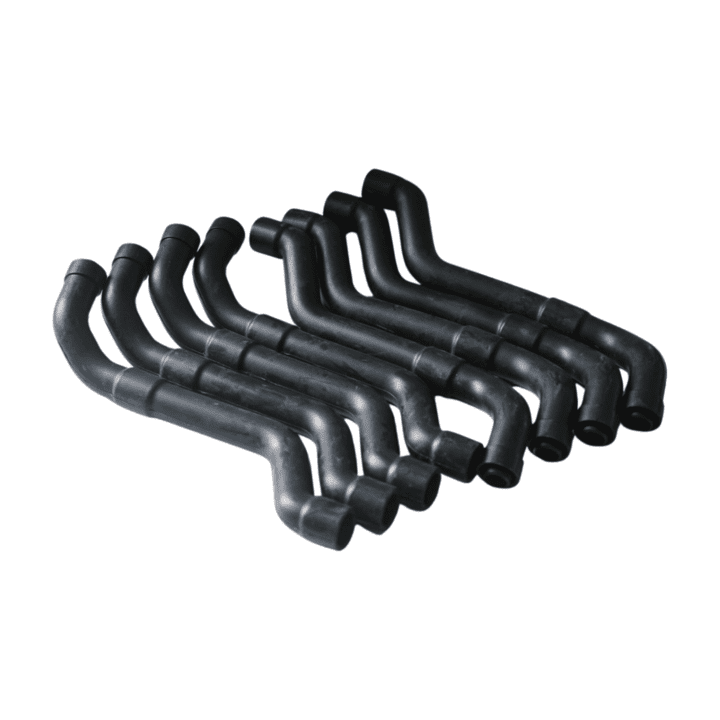Are you trying to decide between PTFE (Polytetrafluoroethylene) and rubber hoses for your application? Understanding the differences in their properties, performance, and suitable uses will help you make the best decision. Let’s compare PTFE and rubber hoses to determine which is better for your needs.
PTFE hoses offer superior chemical resistance and high-temperature stability, while rubber hoses are more flexible and cost-effective, making them ideal for a wide range of applications.

Both PTFE and rubber hoses offer unique advantages depending on the specific requirements of your application. Let’s dive into the properties of each material to understand where they excel and how to make the best choice for your needs.
What Is PTFE Hose?
PTFE (Polytetrafluoroethylene) hose is made from a high-performance thermoplastic that offers excellent resistance to chemicals, high temperatures, and pressure. Let’s take a closer look at PTFE hose and its characteristics.
PTFE hoses are known for their outstanding chemical resistance and ability to withstand high temperatures, making them ideal for demanding industrial and chemical applications.
PTFE hoses are made from a high-performance thermoplastic polymer that is chemically inert and has a non-stick surface. Some of the key properties of PTFE hoses include:
- Chemical Resistance1: PTFE hoses offer excellent resistance to a wide range of chemicals, acids, and solvents, making them ideal for industries like pharmaceuticals, chemicals, and food processing.
- Temperature Resistance2: PTFE hoses can withstand extreme temperatures, with a typical range from -73°C to +260°C, making them suitable for high-temperature applications such as steam and hot liquid transfer.
- Non-Stick Surface: The non-reactive and non-stick properties of PTFE make it suitable for transporting sticky or corrosive fluids without contamination.
- Pressure Resistance: PTFE hoses are known for their ability to handle high-pressure applications, ensuring safety and reliability.
Common applications of PTFE hoses include chemical processing, pharmaceutical, and food industries where high resistance to chemicals and temperatures is required.
What Is Rubber Hose?
Rubber hoses are made from elastomers that provide excellent flexibility, durability, and resistance to wear and abrasion. Let’s explore rubber hoses and their characteristics in more detail.
Rubber hoses are versatile, flexible, and cost-effective, making them ideal for a wide variety of applications, including industrial, automotive, and hydraulic systems.

Rubber hoses are made from different types of rubber compounds, such as Nitrile (NBR), EPDM, or Neoprene, depending on the requirements of the application. Key characteristics of rubber hoses include:
- Flexibility3: Rubber hoses are highly flexible, making them ideal for applications where bending or movement is necessary, such as in automotive or hydraulic systems.
- Durability4: Rubber hoses offer excellent abrasion resistance and are built to withstand harsh environments and physical wear.
- Temperature Resistance: Rubber hoses generally have good temperature resistance, though not as high as PTFE hoses. The typical temperature range for rubber hoses is between -40°C and +150°C, depending on the rubber type.
- Cost-Effectiveness5: Rubber hoses are generally more affordable compared to PTFE hoses, making them a preferred choice for low-cost applications.
Rubber hoses are commonly used in automotive, hydraulic, industrial, and agricultural applications, where flexibility and durability are essential.
What Are the Key Differences Between PTFE and Rubber Hose?
So, what exactly sets PTFE hoses apart from rubber hoses? Let’s break down the key differences based on their properties and applications.
PTFE hoses are superior in chemical and temperature resistance, while rubber hoses offer better flexibility, cost-effectiveness, and ease of use in a variety of applications.

Here’s a breakdown of the key differences between PTFE and rubber hoses:
| Property | PTFE Hose | Rubber Hose |
|---|---|---|
| Chemical Resistance | Excellent resistance to a wide range of chemicals, acids, and solvents. | Good resistance to water, oils, and common chemicals, but not as high as PTFE. |
| Temperature Resistance | Can withstand temperatures from -73°C to +260°C. | Typically withstands temperatures between -40°C and +150°C. |
| Flexibility | Rigid, less flexible compared to rubber. | Highly flexible, ideal for bending and dynamic applications. |
| Pressure Resistance | Excellent pressure resistance, suitable for high-pressure applications. | Good pressure resistance, but less than PTFE. |
| Durability | Extremely durable and resistant to wear, but can be prone to physical damage. | Durable with good abrasion resistance, but can degrade with exposure to heat and UV. |
| Cost | More expensive due to high-performance properties. | Cost-effective, especially in low to medium-performance applications. |
| Ease of Use | Less flexible, harder to work with in tight spaces. | Easy to work with, ideal for tight spaces and flexible applications. |
As you can see, PTFE hoses are best for high-temperature, chemical, and high-pressure environments, whereas rubber hoses excel in applications requiring flexibility, affordability, and general-purpose use.
What Are the Best Applications for PTFE and Rubber Hoses?
Now that we know the differences, which hose material is best for your application? Let’s explore where PTFE and rubber hoses perform best.
PTFE hoses are ideal for applications in the chemical, pharmaceutical, and food industries, while rubber hoses are used in automotive, industrial, and hydraulic systems.

Best Uses for PTFE Hoses:
- Chemical Processing: PTFE hoses6 are ideal for transporting chemicals and solvents in industries like chemical manufacturing and pharmaceuticals, where resistance to corrosion and extreme conditions is required.
- Food and Beverage: PTFE’s non-stick properties make it suitable for applications in food processing, where hygiene and material compatibility are essential.
- High-Temperature Systems: PTFE hoses are used in systems that handle high-temperature fluids, such as steam lines or hot oil transfer.
Best Uses for Rubber Hoses:
- Automotive: Rubber hoses7 are widely used in automotive cooling, fuel lines, and braking systems due to their flexibility and durability.
- Hydraulic and Pneumatic Systems: Rubber hoses are commonly used in hydraulic and pneumatic applications where flexibility and resistance to abrasion are required.
- General Industrial Applications: Rubber hoses are ideal for industrial applications where cost-effectiveness, flexibility, and good resistance to water and oils are necessary.
Conclusion
Choosing between PTFE and rubber hoses depends on your specific needs. PTFE hoses offer superior chemical resistance, high-temperature stability, and pressure resistance, making them ideal for demanding industrial applications. Rubber hoses, on the other hand, provide excellent flexibility, cost-effectiveness, and durability, making them suitable for a wide range of general-purpose applications.
🚀 Need Custom Hose Solutions for Your Specific Application?
Contact Julong Rubber today or Request a Custom Quote for high-quality PTFE and rubber hoses tailored to your needs!
Or reach out to us directly via WhatsApp:

Understanding the chemical resistance of PTFE hoses can help industries choose the right materials for safety and efficiency. ↩
Exploring temperature resistance can guide you in selecting hoses for high-temperature applications, ensuring reliability. ↩
Learning about the flexibility of rubber hoses can help you understand their applications in various industries, enhancing performance. ↩
Discover the factors contributing to the durability of rubber hoses, essential for applications in tough conditions. ↩
Explore this link to understand how rubber hoses can save costs while maintaining performance in various applications. ↩
Explore this link to understand the versatile applications of PTFE hoses in various industries, enhancing your knowledge on their benefits. ↩
Discover the diverse applications of rubber hoses in automotive and industrial sectors, which can help you make informed choices for your projects. ↩







